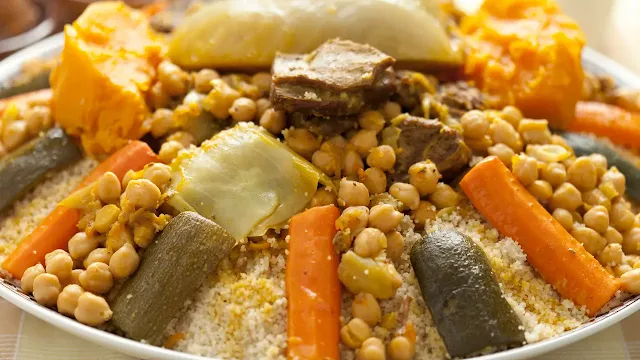In this article, you will learn how to make authentic Moroccan couscous at home, using simple ingredients and techniques.
You will also discover the history and significance of couscous in Moroccan culture and some tips and variations to customize your couscous according to your preferences and dietary needs.
What is Couscous and How is it Made?
Couscous is a type of pasta that originated in North Africa and is widely consumed in Morocco, Algeria, Tunisia, Libya, and other countries in the region.
The word couscous comes from the Berber language, and means “well rolled” or “well-formed”. This refers to the process of making couscous, which involves mixing semolina flour with water and rolling it into small granules with the palms of the hands.
The granules are then steamed in a special pot called a couscoussier, which consists of two parts: a lower part that holds the broth, and an upper part that holds the couscous.
The steam from the broth cooks the couscous and also infuses it with flavor and aroma.
Exploring the World of Couscous: Types, Flours, and Culinary Varieties
Couscous can be made from different types of flour, such as wheat, barley, millet, or corn. The size and shape of the couscous granules can also vary, from fine to coarse, and from round to irregular.
In Morocco, the most common type of couscous is made from durum wheat and has a medium size and a yellowish color.
What are the Ingredients and Spices Used in Moroccan Couscous?
Moroccan couscous is usually cooked with a variety of vegetables, meat, and spices, and served with a rich broth. The vegetables can include carrots, turnips, zucchini, squash, eggplant, cabbage, onions, tomatoes, chickpeas, and more.
The meat can be lamb, beef, chicken, or fish, depending on the region and the occasion.
The spices can include salt, pepper, ginger, turmeric, paprika, cumin, saffron, cinnamon, and more. The broth can be made from water, stock, tomato sauce, or a combination of these.
The most popular and traditional version of Moroccan couscous is couscous with seven vegetables, which is considered a lucky dish and a symbol of abundance.
It is usually topped with a caramelized onion and raisin garnish called "Tfaya", which adds sweetness and contrast to the savory couscous.
 |
| Moroccan Cuisine Home-made Couscous Tfaya |
Another common version is couscous with chicken and caramelized pumpkin, which is often prepared for special occasions and celebrations.
How to Make Moroccan Couscous at Home?
Making Moroccan couscous at home is not difficult, but it does require some time and patience. You will need a couscoussier, or a similar pot with a steaming basket, to cook the couscous properly.
You will also need a large bowl, a fork, a spoon, a knife, a cutting board, and a measuring cup.
Here are the basic steps to make Moroccan couscous at home:
Prepare the couscous
Prepare the broth
Prepare the vegetables
Steam the couscous
Serve the couscous
What are the Benefits and Tips for Making Moroccan Couscous at Home?
Making Moroccan couscous at home has many benefits, such as:
- You can control the quality and quantity of the ingredients, and choose the ones that suit your taste and budget.
- You can customize the couscous according to your preferences and dietary needs, such as using whole wheat couscous, adding more or less spices, or omitting the meat for a vegetarian option.
- You can enjoy a healthy and balanced meal, as couscous is rich in carbohydrates, protein, fiber, vitamins, and minerals, and the vegetables provide antioxidants and phytochemicals.
- You can experience the authentic Moroccan cuisine and culture, and share it with your family and friends.
Some tips to make Moroccan couscous at home are:
- Use a large and deep couscoussier, or a similar pot with a steaming basket, to ensure that the couscous and the broth have enough space and steam to cook properly.
- Use a fine mesh or a cheesecloth to cover the steaming basket, to prevent the couscous from falling into the broth.
- Use a fork to fluff the couscous, and avoid using a spoon or a spatula, as they can make the couscous sticky and mushy.
- Use a generous amount of broth, butter, or oil, to keep the couscous moist and flavorful, and avoid drying it out.
- Serve the couscous hot, and reheat it if needed, as it can lose its texture and taste when it cools down.
Conclusion
Moroccan couscous is a delicious and nutritious dish that you can make at home, using simple ingredients and techniques.
It is a versatile dish that can be adapted to your preferences and dietary needs, and it is a great way to enjoy authentic Moroccan cuisine and culture.
Try making Moroccan couscous at home, and let us know how it turned out!


